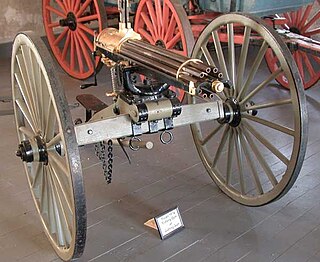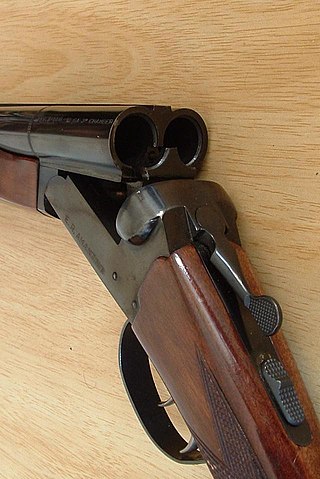
The Gatling gun is a rapid-firing multiple-barrel firearm invented in 1861 by Richard Jordan Gatling. It is an early machine gun and a forerunner of the modern electric motor-driven rotary cannon.

A machine gun is a fully automatic, rifled autoloading firearm designed for sustained direct fire with rifle cartridges. Other automatic firearms such as automatic shotguns and automatic rifles are typically designed more for firing short bursts rather than continuous firepower, and are not considered true machine guns. Submachine guns fire handgun cartridges rather than rifle cartridges and thus are not considered machine guns, while automatic firearms of 20 mm (0.79 in) caliber or more are classified as autocannons rather than machine guns.

A submachine gun (SMG) is a magazine-fed, automatic carbine designed to fire handgun cartridges. The term "submachine gun" was coined by John T. Thompson, the inventor of the Thompson submachine gun, to describe its design concept as an automatic firearm with notably less firepower than a machine gun. As a machine gun must fire rifle cartridges to be classified as such, submachine guns are not considered machine guns.

In firearms terminology, an action is the functional mechanism of a breech-loading firearm that handles the ammunition cartridges, or the method by which that mechanism works. Actions are technically not present on muzzleloaders, as all those are single-shot firearms with a closed off breech with the powder and projectile manually loaded from the muzzle. Instead, the muzzleloader ignition mechanism is referred to as the lock.

The Thompson submachine gun is a blowback-operated, selective-fire submachine gun, invented by United States Army brigadier general John T. Thompson in 1918. It was originally designed to break the stalemate of trench warfare of World War I, but was not finished until after the war ended.

John Moses Browning was an American firearm designer who developed many varieties of military and civilian firearms, cartridges, and gun mechanisms – many of which are still in use around the world. He made his first firearm at age 13 in his father's gun shop and was awarded the first of his 128 firearm patents on October 7, 1879, at the age of 24. He is regarded as one of the most successful firearms designers of the 19th and 20th centuries and pioneered the development of modern repeating, semi-automatic, and automatic firearms.

The Browning Automatic Rifle (BAR) is a family of American automatic rifles and machine guns used by the United States and numerous other countries during the 20th century. The primary variant of the BAR series was the M1918, chambered for the .30-06 Springfield rifle cartridge and designed by John Browning in 1917 for the American Expeditionary Forces in Europe as a replacement for the French-made Chauchat and M1909 Benét–Mercié machine guns that US forces had previously been issued.

The .45 Reising submachine gun was manufactured by Harrington & Richardson (H&R) Arms Company in Worcester, Massachusetts, USA, and was designed and patented by Eugene Reising in 1940. The three versions of the weapon were the Model 50, the folding stock Model 55, and the semiautomatic Model 60 rifle. Over 100,000 Reisings were ordered during World War II, and were initially used by the United States Navy, Marine Corps, and the United States Coast Guard, though some were shipped to Canadian, Soviet, and other allied forces to fight the Axis powers.
Blowback is a system of operation for self-loading firearms that obtains energy from the motion of the cartridge case as it is pushed to the rear by expanding gas created by the ignition of the propellant charge.

The Hyde-Inland M2 was a United States submachine gun design submitted for trials at Aberdeen Proving Ground in February 1941. Work was undertaken by General Motors Inland Manufacturing Division to develop workable prototypes of George Hyde's design patented in 1935. The model first submitted for trials in April 1942 was designated the Hyde-Inland 1. Trials revealed the design was superior to the M1 submachine gun in mud and dirt tests, and its accuracy in full-automatic firing was better than any other submachine gun tested at the time. An improved Hyde-Inland 2 was designated U.S. Submachine gun, Caliber .45, M2 as a substitute standard for the M1 Thompson in April 1942. As Inland's manufacturing capacity became focused on M1 carbine production, the US Army contracted M2 production to Marlin Firearms in July 1942. Marlin began production in May 1943. Marlin's production failed to match the trials prototype performance; and Marlin's original contract for 164,450 M2s was canceled in 1943 upon adoption of the M3 submachine gun. The M2 is chambered for the .45 ACP cartridge and used the same 20- or 30-round magazine as the Thompson. Its cyclic rate of fire is 570 rounds per minute. None of the approximately 400 manufactured were issued by any branches of the United States military.

Gas-operation is a system of operation used to provide energy to operate locked breech, autoloading firearms. In gas-operation, a portion of high-pressure gas from the cartridge being fired is used to power a mechanism to dispose of the spent case and insert a new cartridge into the chamber. Energy from the gas is harnessed through either a port in the barrel or a trap at the muzzle. This high-pressure gas impinges on a surface such as a piston head to provide motion for unlocking of the action, extraction of the spent case, ejection, cocking of the hammer or striker, chambering of a fresh cartridge, and locking of the action.
Professor Craig Kennedy is a character created by Arthur B. Reeve.
Francis Conrad Osborn Sr. was a teacher, businessman and inventor. He held about 50 patents for cash register designs, springless scales, and other devices.

John White Howell was an American electrical engineer who spent his entire professional career working for Thomas Edison, specializing in the development and manufacturing of the incandescent lamp.

Auto-Ordnance was a U.S. arms development firm founded by retired Colonel John T. Thompson of the United States Army Ordnance Department in 1916. Auto-Ordnance is best known for the Thompson submachine gun, used as a military weapon by the Allied forces in World War II, and also notorious as a gangster weapon used during the Roaring Twenties.
Recoil operation is an operating mechanism used to implement locked breech, autoloading firearms. Recoil operated firearms use the energy of recoil to cycle the action, as opposed to gas operation or blowback operation using the pressure of the propellant gas.
The smartphone wars or smartphone patents licensing and litigation refers to commercial struggles among smartphone manufacturers including Sony Mobile, Google, Apple Inc., Samsung, Microsoft, Nokia, Motorola, Huawei, LG Electronics, ZTE and HTC, by patent litigation and other means. The conflict is part of the wider "patent wars" between technology and software corporations.

Frederic Waller was an American inventor and film pioneer.

A repeating firearm or repeater is any firearm that is capable of being fired repeatedly before having to manually reload new ammunition into the weapon.
Roach W. N. (1924). Recent Patents – Brief Descriptions of Inventions of Interest to Ordnance Engineers. Army Ordnance – The Journal of the Army Ordnance Association, IV(23), 347.













